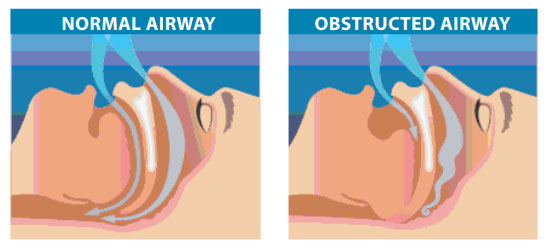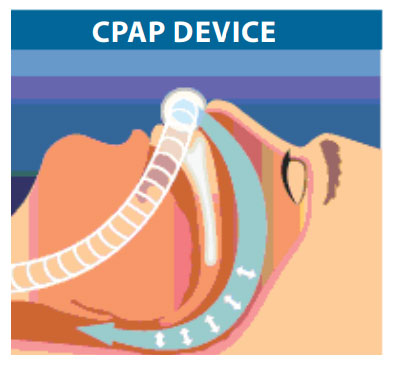Obstructive sleep apnoea (OSA) is a common problem that affects a person’s breathing during sleep. A person with OSA has times during sleep in which air cannot flow normally into the lungs. The block in airflow (obstruction) is usually caused by the collapse of the soft tissues in the back of the throat (upper airway) and tongue during sleep.
Apnoea means not breathing. In OSA, you may stop breathing for short periods of time. Even when you are trying to breathe, there may be little or no airflow into the lungs. These pauses in airflow (obstructive apnoea) can occur off and on during sleep, and cause you to wake up from a sound sleep. Frequent apnoea can cause many problems. With time, if not treated, serious health problems may develop.
OSA is more common in men, women after menopause and people who are over the age of 65. OSA can also occur in children. There are several groups of people who are particularly at risk for developing OSA. People who are overweight are more likely to develop sleep apnoea. OSA can occur in people who have large tonsils or adenoids. OSA can also run in families of people of normal size and in people with certain types of jaw problems. People with these jaw problems have difficulty keeping the back of their throat open. Some of these conditions are called micrognathia (a small jaw) and retrognathia (a pulled back jaw).

WHAT ARE THE SYMPTOMS OF OBSTRUCTIVE SLEEP APNOEA?
There are many clues that tell your doctor that you may have OSA. You may not be aware that you have OSA, but these symptoms may be more obvious to a spouse, other family member, or close friend
Common symptoms you may have during sleep
- Snoring that is usually loud and bothers other people trying to sleep near you. Snoring can come and go through the night.
- Gasping or choking sounds
- Breathing pauses observed by someone watching you sleep.
- Sudden or jerky body movements
- Restless tossing and turning
- Frequent awakenings from sleep
Common symptoms you may have while awake
- Wake up feeling like you have not had enough sleep, even after sleeping many hours
- Morning headache
- Dry or sore throat in the morning from breathing through your mouth during sleep
- Sleepiness during the day
- Fatigue or tiredness through the day
- Personality changes, such as mood swings and difficulty getting along with others
- Problems with poor memory or inability to concentrate
CAN OSA BE DANGEROUS?
Lack of sleep can cause you to fall asleep while driving and result in car accidents. Periods of stopping breathing can, with time, cause high blood pressure (hypertension), heart disease, stroke or early death.
HOW DO I KNOW I HAVE OSA?
The signs of OSA described above should make you seek help for an evaluation. Discuss your problems with your health care provider. They can sort through some of the problems you are having and determine whether you should be evaluated further at a sleep centre.
OSA is diagnosed by a sleep study (or polysomnogram). A sleep study is generally done at a sleep centre where you will be scheduled to sleep overnight. During this time, your breathing, heart rate, sleep state and oxygen levels will be monitored.
HOW IS OBSTRUCTIVE SLEEP APNOEA TREATED?
Sleep apnoea can be effectively treated, and there are a number of ways to do so. The type of treatment recommended will depend on the reason for and severity of the sleep apnoea. If your OSA is from being overweight, weight loss may cause the apnoea to go away completely. You can avoid alcohol for at least 4 hours before going to bed. If you sleep on your back, you can use a pillow or some other strategy to force yourself to sleep on your side. Some people sew a tennis ball into their pyjama bottoms to remind them not to turn on their back.

Continuous Positive Airway Pressure (CPAP) is a common device ordered to treat most conditions of OSA. CPAP is delivered by a compressor that blows air (with or without oxygen) into a mask that is worn snugly over the nose and or mouth during sleep. The flow of air acts like a splint to keep the upper airway from collapsing. This helps prevent obstruction and the apnoea from occurring. The air pressure is adjusted to a setting that best controls the apnoea. Often a person will also notice much less snoring when wearing CPAP.
There are devices and surgeries which can be done to treat OSA. The type of device or surgery will depend on what has cause the apnoea. Some appliances or devices (called oral devices) that are worn in the mouth during sleep may keep your airway open. Most oral devices work by either bringing the jaw forward or keeping the tongue from blocking the throat. Oral appliances are most likely to help a person who has mild sleep apnoea and who is not overweight. These devices are usually custom-made and fitted under the supervision of a specialized dentist or oral surgeon who works with these problems.
Surgery may be recommended in some cases. When the tonsils or adenoids are causing the throat to be blocked, a tonsillectomy may be recommended. Surgery may also be helpful for patients with jaw problems. Other surgeries for OSA either clear out the tissue from the back of the throat or reposition the tongue forward. These surgeries are not, however, as effective as CPAP to control your OSA and are usually reserved for patients who fail CPAP.
Action Steps:
- Talk with your doctor if you have symptoms of obstructive sleep apnoea
- Ask people who are around you when you sleep if they have heard loud snoring or saw you have apnoea spells
- Ask your health care provider if you need a sleep study
- Exercise regularly and work to lose weight if you are overweight
- Avoid alcohol, particularly just prior to sleep

 Vi
Vi 












